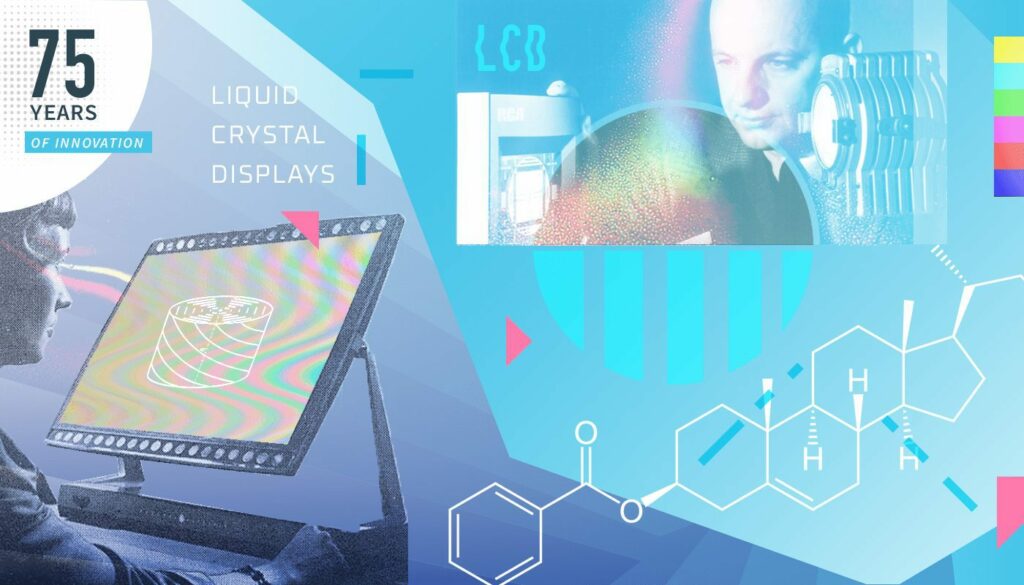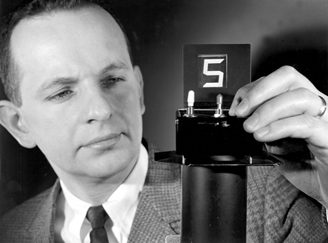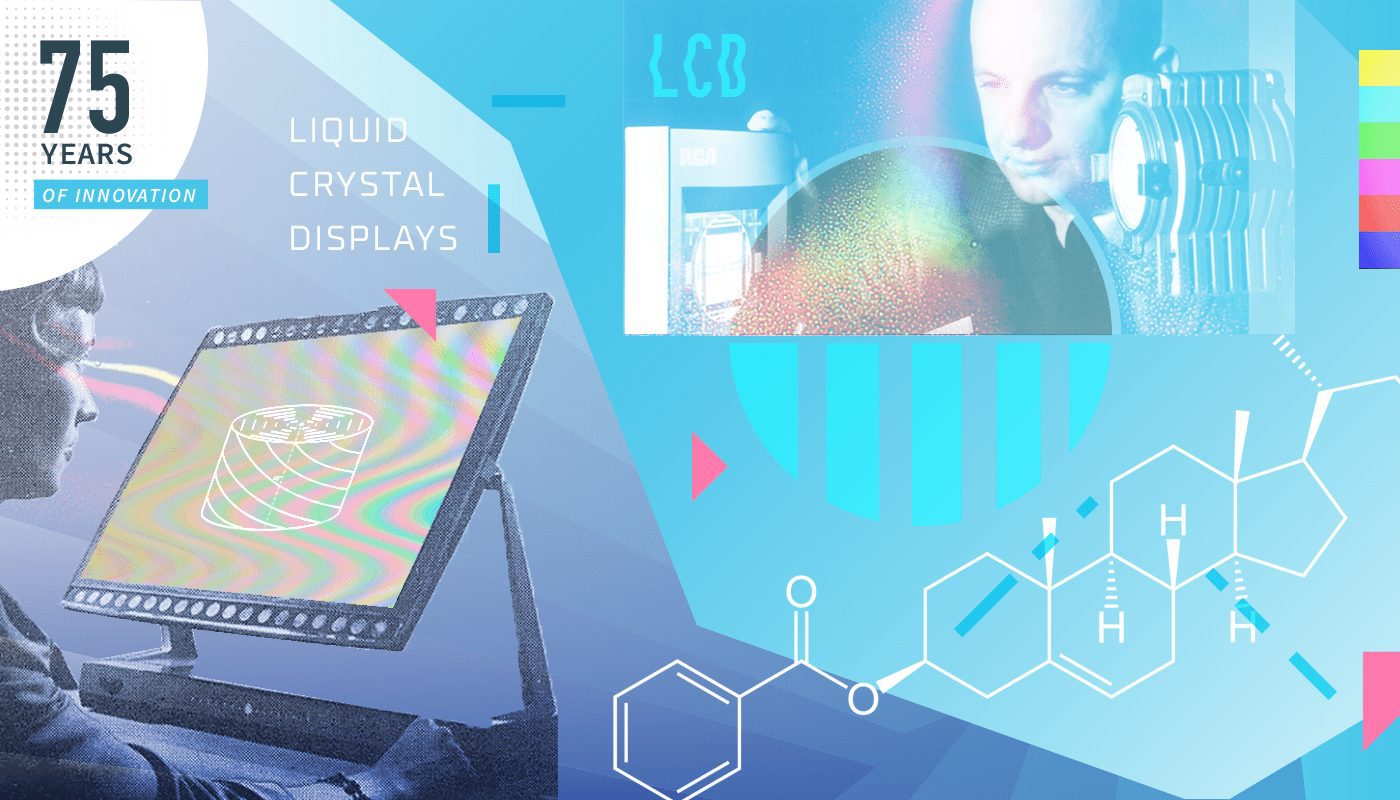The technology behind modern flat panel displays that have helped drive innovation in smart technologies.
The 75 Years of Innovation series highlights the groundbreaking innovations spanning from SRI’s founding in 1946 to today. Each week, SRI will release an innovation, leading up to its 75th anniversary in November 2021.

Shining a Light on Liquid Crystal Displays
“Among the benefits that might ultimately result from the development are: A thin television screen that can be hung on the living-room wall like a painting.” — New York Times article quoting from an RCA conference in May 1968 announcing LCD
When historians look back on our modern era, they will list a number of defining features of the age. Alongside the Internet will be the ubiquitous nature of the ‘screen’. No matter where you go, home, work, traveling, look around and you will likely see display screens everywhere. From the smartwatch on your wrist to the smartphone you are using to read this to your TV screen, the technology behind that screen, Liquid Crystal Display (LCD) has been a vital part of making our modern world shine.
‘Liquid crystals’ were first discovered in 1888 by botanist Freidrich Reinitzer. However, LCD as a technological innovation for light displays entered the world as a unique and powerful solution to the power-hungry LED back in the 1960s.
LCD technology offers low operating power, high image quality with good contrast, and a long operating life. Together with other technologies like thin-film-transistor (TFT), LCD is a vital enabler behind the development of innovative new technologies.
The Technology Behind Liquid Crystal Display (LCD)
In the early 1960s, George H. Heilmeier was a Ph.D. student in electrical engineering, working for RCA Laboratories (later acquired by SRI International). He was interested in organic semiconductors, carbon-based molecules that exist in the form of crystals or thin films. From this interest area, he moved into the field of electro-optic effects in liquid crystals; 1964 was the year that Heilmeier discovered several new types of effect. From this work, Heilmeier became the first person to demonstrate a working LCD display. Heilmeier then went on to be DARPA Director and created the Heilmeier Catechism. The rest is history…But what makes a Liquid Crystal Display work?
The effectiveness of an LCD depends on two properties:
● Purity
● Ability to resist current (resistivity)
Heilmeier also determined two mechanisms of the modes of operation of LCD. Heilmeier placed different dyes into the crystal cell and then passed a current through. He noted that the dyes would change color and that this color could be controlled by varying the current: This was termed the “guest-host (GH) effect”.
The experiments continued. It was found that when light was shone onto a liquid crystal cell and then an electric current applied, the cell would turn a milky white color. If the current was increased, the opacity would also increase. This was theorized to be caused by the current changing the orientation of the liquid crystal molecules and causing light to be scattered at various angles. Heilmeier then noted the light scattered in a forward direction and this phenomenon was used to improve the brightness of displays. To do so, Heilmeier placed reflective material onto the side of a cell in the direction of the scattered light; this caused the photons to bounce back into the cell and brighten the display.
The elements of Liquid Crystal Display had been determined.

The Place of LCD in the History of Technology
In May 1968, RCA held a press conference at its headquarters in Manhattan, New York, USA. At the conference, they handed out images of the first LCD digital clock.
LCD was a vitally needed replacement technology for the heavy power consuming Light Emitting Diodes (LED) and Vacuum Fluorescent Displays (VFD) used in consumer products like watches and calculators; optimizing battery life for battery-powered devices was an important step in the development of consumer electronic products.
Eventually, LCD evolved to work with the much larger screens that we see in use today.
LCD technology changed the world of displays, true. But it also pushed other technologies into new markets.
LCD has spawned new and even more innovative display types including thin-film-transistor liquid-crystal display (TFT-LCD), the market value of which is expected to be $195 billion by 2023. The development of LCD into a commercially useful technology drove the development of low-power and portable screens that our highly connected world of smartphones, laptops, touch-screen computers, and many IoT devices depend on.
George H. Heilmeier died in 2014, but the era of the screen is down to his clever manipulation of light using liquid crystals. In 2009 George Heilmeier was rewarded with inclusion in the National Inventors Hall of Fame.
Resources
Market Watch, Size of TFT-LCD Market to 2023: https://www.marketwatch.com/press-release/tft-lcd-market-size-to-reach-195-billion-by-2023-research-cosmos-2019-04-18
National Inventors Hall of Fame: https://www.invent.org/inductees/george-heilmeier
Research Papers
Williams R, Heilmeier GH. 1966. Possible ferroelectric effects in liquid crystals and related liquids. Journal of Chemical Physics 44:638–643.
Heilmeier GH, Zanoni LA, Barton LA. 1968. Dynamic scattering: A new electrooptic effect in certain classes of nematic liquid crystals. Proceedings of the IEEE 56(7):1162–1171.
George H. Heilmeier, “Liquid Crystal Displays: An Experiment in Interdisciplinary Research that 61 Worked,” IEEE Trans. on Electron Devices ED-23, no. 7 (Jul. 1976): 780–785.



